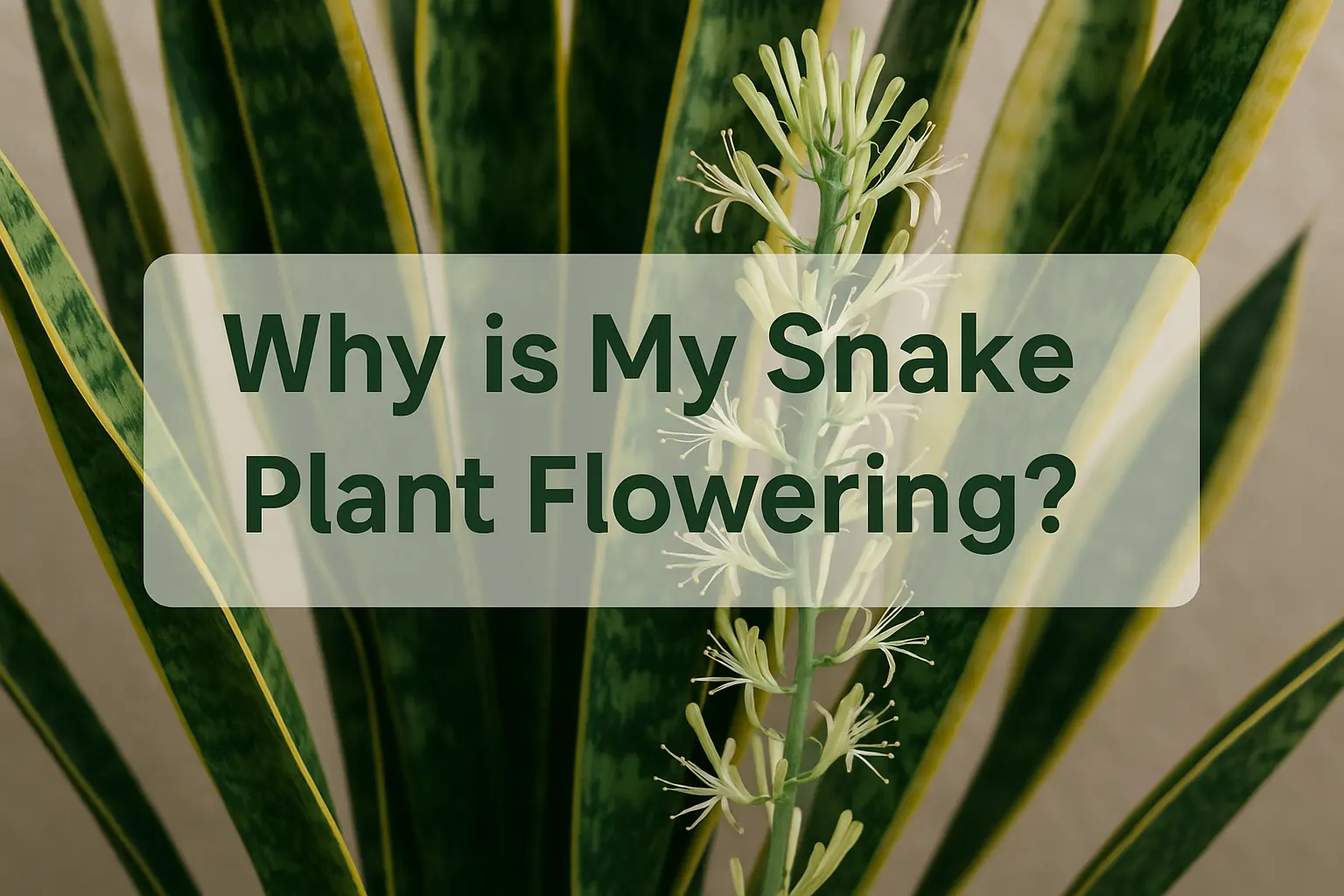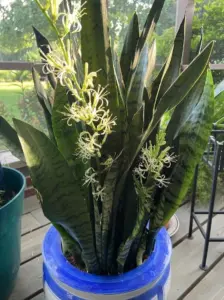Why is My Snake Plant Flowering?

You wake up one morning and notice something unusual about your snake plant. There’s a tall, slender spike shooting up from the center with small white flowers clustered along it. If you’re like most people, your first thought might be “Is my plant dying?” Don’t worry – your snake plant isn’t on its last legs. In fact, flowering is a completely natural process that reveals fascinating insights about your plant’s condition.
Snake plants producing flowers is surprisingly uncommon for houseplants, which is why it catches so many people off guard. These blooms are actually quite special, and understanding why they happen can help you become a better plant parent.
Table of Contents
What Snake Plant Flowers Look Like?
Snake plant flowers are nothing like the bold, colorful blooms you might expect from typical flowering houseplants. They appear on a tall, thin green stalk that emerges from the center of the plant. Small, tubular white or cream-colored flowers cluster along this spike, opening from bottom to top over several days.
The most remarkable feature of these flowers is their fragrance. Many people describe the scent as sweet and honey-like, with some detecting notes of vanilla or even lavender. The flowers typically open at night and release their strongest fragrance in the evening hours, which makes sense since they evolved to attract nighttime pollinators in their native African habitat.
Some varieties produce flowers with slight variations in color – you might see hints of pink, yellow, or green depending on your specific snake plant type. The flowers often produce a sticky nectar, which is completely normal and nothing to worry about.
Why is Your Snake Plant Flowering?
There’s a persistent myth that flowering signals your snake plant is dying, but this isn’t true. The reality is more nuanced and actually quite fascinating from a biological perspective.
Snake plants flower primarily due to what botanists call “reproductive stress.” This doesn’t mean your plant is unhappy or dying – it means the plant has reached a point where it feels compelled to reproduce. This can happen for several reasons, and understanding them helps explain the seemingly random nature of snake plant blooms.
Maturity and Age
Older, more established snake plants are much more likely to flower than young ones. A snake plant needs to reach a certain level of maturity before it has the energy reserves necessary to produce flowers. This is why you might have owned a snake plant for years without seeing a single bloom, only to have it suddenly flower after reaching peak maturity.
Pot-Bound Conditions
One of the most common triggers for snake plant flowering is being root-bound. When your plant’s roots have completely filled its pot and have nowhere else to grow, this creates a mild stress condition that often prompts flowering. The plant essentially thinks, “My growing space is limited, so I better reproduce while I can.”
This doesn’t mean your plant is suffering, but it does indicate that repotting might be beneficial after the flowering period ends. The restricted root space mimics the challenging growing conditions snake plants face in their native environment, where space and resources can be limited.
Light Conditions
Despite their reputation as low-light plants, snake plants actually need bright light to flower. Many people keep their snake plants in darker corners of rooms, which is fine for general health but won’t encourage blooming. Plants that receive bright, indirect light or even some direct sunlight are much more likely to produce flowers.
The increased light exposure signals to the plant that conditions are favorable for reproduction. In nature, more light often means better growing conditions and a higher chance of successful seed development.
Seasonal Changes
Snake plants are most likely to flower during spring and early summer. The longer days and increased light intensity during these seasons align with their natural growing cycle. Even indoors, plants can sense the changing seasons through variations in daylight duration and intensity.
The transition from winter dormancy to active spring growth often acts as a natural trigger for flowering. Your plant has been conserving energy during the darker winter months and is now ready to put that energy toward reproduction.
Temperature Fluctuations
Moderate temperature changes can also encourage flowering. This doesn’t mean subjecting your plant to extreme temperature swings, but rather the natural temperature variations that occur seasonally or even between day and night.
Plants that experience slight temperature variations often flower more readily than those kept in perfectly stable conditions. This mimics their natural environment where temperatures fluctuate regularly.
Watering Patterns
Changes in watering routine sometimes coincide with flowering, though this is more correlation than causation. Some plant owners notice their snake plants bloom after adjusting their watering schedule, particularly if they’ve been allowing the soil to dry out more thoroughly between waterings.
The key is consistency rather than any specific watering frequency. Snake plants prefer to dry out completely between waterings, and maintaining this pattern helps keep the plant healthy enough to support flowering when other conditions align.
Is Your Plant Stressed or Happy?
This question comes up frequently among snake plant owners, and the answer isn’t straightforward. Flowering can indicate both mild stress and good health, depending on the specific circumstances.
Signs of a Healthy Flowering Plant
A healthy snake plant that’s flowering will have:
- Firm, upright leaves with good color
- No signs of rot or damage
- Steady growth of new leaves
- Strong root system (even if pot-bound)
If your flowering snake plant shows these characteristics, the bloom is likely a sign of maturity and good overall health rather than distress.
When Flowering Might Indicate Problems
Flowering could signal issues if it’s accompanied by:
- Yellowing or soft leaves
- Stunted growth
- Signs of root rot
- Recent major environmental changes
In these cases, the plant might be flowering as a last-ditch reproductive effort before declining health becomes a bigger problem.
What to Do When Your Snake Plant Flowers?
Discovering your snake plant in bloom is exciting, but you might wonder if you need to take any special action. The good news is that flowering snake plants don’t require dramatically different care.
Continue Normal Care
Keep watering on your regular schedule, allowing the soil to dry completely between waterings. Don’t increase watering frequency just because the plant is flowering – this can actually harm the plant.
Maintain the same light conditions that prompted the flowering in the first place. Moving the plant to a different location during blooming can stress it unnecessarily.
Enjoy the Fragrance
Take advantage of the evening fragrance by placing the plant where you’ll notice the scent. Many people move their flowering snake plants temporarily to bedrooms or living areas to enjoy the sweet aroma during the blooming period.
Consider Future Repotting
If your plant is severely pot-bound, plan to repot it after the flowering period ends. This gives the plant time to focus its energy on the blooms without the additional stress of adjusting to a new pot and soil.
Remove Spent Flowers
Once the flowers fade and the stalk begins to look dried out, you can cut it off at the base. Use clean scissors or pruning shears to make a clean cut close to the soil level. This prevents the plant from putting energy into seed production and redirects that energy back to leaf growth.
How Long Do Snake Plant Flowers Last?
Snake plant blooms typically last two to four weeks, depending on environmental conditions and the health of the plant. The flowers open gradually from bottom to top over several days, so you’ll have an extended period to enjoy them.
The fragrance is usually strongest during the first week or two of blooming. As the flowers age, they may become less fragrant and eventually begin to fade. Some flowers produce small berries after pollination, though this is less common in indoor settings.
Don’t be disappointed when the flowers eventually fade – this is completely normal. The energy your plant put into flowering will now redirect to producing new growth and maintaining healthy leaves.
Will Your Snake Plant Flower Again?
Many snake plant owners wonder if their plant will bloom again in future years. The answer depends on several factors, but repeat blooming is certainly possible.
Plants that have flowered once are more likely to flower again, especially if the conditions that triggered the first bloom remain consistent. However, snake plants don’t flower on a predictable schedule like some other plants.
Some snake plants bloom annually during spring, while others might skip years between flowering periods. A few fortunate plant owners report multiple blooming periods in a single year, though this is relatively rare.
The best approach is to continue providing good care without specifically trying to force blooming. Maintain bright light, appropriate watering, and allow the plant to become pot-bound again over time. If conditions align properly, you may be rewarded with future blooms.
Conclusion
The flowering of your snake plant is a special event that reflects the plant’s maturity and, in most cases, its good health. Rather than worrying about whether something is wrong, take time to appreciate this rare occurrence. The sweet fragrance and delicate flowers provide a wonderful contrast to the plant’s typically bold, architectural appearance.
Frequently Asked Questions (F.A.Q)
How often do snake plants flower?
Most snake plants flower once per year at most, typically during spring or early summer. However, many snake plants never flower indoors, and some may skip years between blooming periods. There’s no guaranteed schedule for snake plant flowering.
Should I cut off the flower stalk?
You can leave the flower stalk until it naturally dries out and the flowers fade, which usually takes 2-4 weeks. Once the flowers are spent, cut the stalk at the base with clean scissors to redirect the plant’s energy back to leaf growth.
Does flowering mean I need to repot my snake plant?
Not immediately. If your plant is severely pot-bound, plan to repot after the flowering period ends. However, mild root crowding often triggers flowering, so you don’t need to rush into repotting just because blooms appeared.
Will my snake plant die after flowering?
No, snake plants don’t die after flowering. This is a common myth. Healthy snake plants continue growing normally after blooming, and many will flower again in future years.
Can I make my snake plant flower?
You can’t force flowering, but you can create favorable conditions. Provide bright, indirect light, allow the plant to become slightly pot-bound, maintain consistent watering (letting soil dry between waterings), and be patient. Mature plants are more likely to bloom than young ones.
Are snake plant flowers toxic to pets?
Yes, snake plant flowers contain the same compounds as the leaves and are mildly toxic to cats and dogs if ingested. Keep flowering plants away from pets, and contact your veterinarian if you suspect your pet has eaten any part of the plant.







